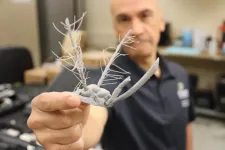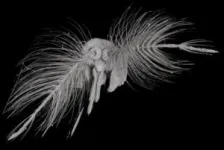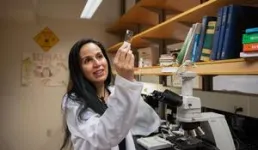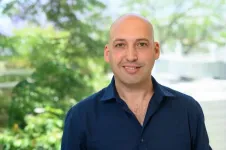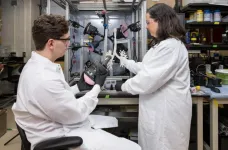(Press-News.org) One of nature’s most disliked creatures may very well unlock a breakthrough in disaster response.
A multidisciplinary Purdue University research team is recreating mosquito antennae to better study their sensitivity to vibrations. Should the research prove fruitful, it could lead to improvements in monitoring and detecting natural disasters such as earthquakes and tsunamis.
Research groups under Purdue professors Pablo Zavattieri and Ximena Bernal conducted this work, which is published in the journal Acta Biomaterialia.
“We’re still in the early stages but we’re pretty optimistic that we’ll at least learn a great deal,” said Zavattieri, the Jerry M. and Lynda T. Engelhardt Professor of Civil Engineering in Purdue’s College of Engineering. “Taking inspiration from nature and using it to advance scientific research has been a core feature of engineering since the very beginning.”
Despite lacking traditional ears, mosquitoes rely on their antennae to navigate the auditory landscape, homing in on crucial sounds amid the background noise of their own wingbeats.
Through analysis of the mosquitoes’ antennal features — particularly the arrangement and morphology of sensory hairs — civil and construction engineering PhD candidate and team researcher Phani Saketh Dasika (MSCE ’23) said they have already gained profound insights into how these adaptations enhance the auditory sensitivity and selective response to environmental cues.
“Using advanced micro-CT imaging to create high-fidelity CAD models for finite element analysis, we found that the architectural features of mosquito antennae enable species- and sex-specific acoustic target detection, even amid nontarget signals like their own wingbeats,” Dasika said. “Our findings also suggest that mosquito antennae are capable of detecting a broader range of frequencies than previously thought, though not all of these may be actively utilized.”
The team’s findings have provided key information for determining if a mosquito’s antennae could inform the design of acoustic sensors.
“By modeling and contrasting the response of the antenna of species of mosquito using sound for different purposes, hearing mates or eavesdropping on frogs, we were able to tease apart features modulating hearing sensitivity and tuning,” said Bernal, a professor of biological sciences in Purdue’s College of Science. “Understanding how these structures work is the first step toward developing acoustic sensors inspired by their sensitive antennae.”
In terms of societal impact, insights from mosquito antennae could also inform the development of smart noise-canceling materials, Zavattieri said. These materials, potentially incorporating microfluidic channels or tunable metamaterials, could be used to create soundproofing panels for buildings, noise-canceling headphones or even acoustic cloaking devices.
“Imagine urban environments equipped with bio-inspired sensors, akin to ‘big ears,’ capable of discerning specific sounds amid the hustle and bustle of city life,” Zavattieri said. “In times of crisis — such as earthquakes or other disasters — these sensors become invaluable, swiftly detecting faint signals of distress and guiding rescue efforts to those in need.”
Zavattieri said the team is currently focused on recreating the antennae through 3D printing, using different materials and at varying sizes for frequency testing.
This research is funded by the Air Force Office of Scientific Research Multi-University Research Initiative (AFOSR-FA9550-15-1-0009) and the National Science Foundation (IOS-2054636).
Writer: Drew Stone, director of marketing and communications, Purdue University Lyles School of Civil and Construction Engineering
END
How mosquitos hear may inspire new ways to detect natural disasters
2025-02-20
ELSE PRESS RELEASES FROM THIS DATE:
Child ADHD risk linked to mother’s use of acetaminophen
2025-02-20
Fetal acetaminophen exposure increases the likelihood that a child will develop attention-deficit/hyperactivity disorder (ADHD), according to a study published Feb. 6 in Nature Mental Health.
Prior research shows that upward of 70% of pregnant women use acetaminophen during pregnancy to control pain or reduce fever. The drug, which is the active ingredient of many pain-relief medications, is one of the few considered safe to take during pregnancy by the U.S. Food and Drug ...
New solution to help therapy ‘dropouts’
2025-02-20
‘The most common number of therapy sessions people access is one’
Common in other countries but not in the U.S., single-session interventions are designed to treat patients in just one meeting
Lab at Northwestern offers digital single-session interventions for youth in nine languages
CHICAGO --- Seeking mental health help is a significant step, but that first intake session can often feel more like paperwork than progress, and a significant proportion of people “drop out” or never return for a second visit, previous research has shown.
“The most common number of sessions ...
New AI system accurately maps urban green spaces, exposing environmental divides
2025-02-20
A research team led by Rumi Chunara - an NYU associate professor with appointments in both the Tandon School of Engineering and the School of Global Public Health – has unveiled a new artificial intelligence (AI) system that uses satellite imagery to track urban green spaces more accurately than prior methods, critical to ensuring healthy cities.
To validate their approach, the researchers tested the system in Karachi, Pakistan's largest city where several team members are based. Karachi proved an ideal test case with its mix of dense urban areas and varying vegetation conditions.
Accepted for publication by the ACM Journal on Computing and Sustainable Societies, ...
Gordon Keller receives the 2025 ISSCR Achievement Award for his seminal work in regenerative medicine
2025-02-20
The International Society for Stem Cell Research (ISSCR) is honoring Gordon Keller, Ph.D., with this year’s ISSCR Achievement Award. Dr. Keller is the Director of the McEwen Stem Cell Institute at the University Health Network (UHN) in Toronto, Canada. He will present his research at the ISSCR 2025 Annual Meeting taking place in Hong Kong 11-14 June 2025.
“Gordon Keller's groundbreaking work in regenerative medicine has illuminated the path to transforming human health,” said Andrea Ditadi, Group Leader, San Raffaele Telethon Institute for Gene Therapy (SR-TIGET), Italy, who led the nomination of Dr. Keller. “From ...
Yonatan Stelzer earns the 2025 ISSCR Outstanding Young Investigator Award for his breakthrough approaches to addressing fundamental problems in mammalian development
2025-02-20
The International Society for Stem Cell Research (ISSCR) is honoring Yonatan Stelzer, Ph.D. with the 2025 ISSCR Outstanding Young Investigator Award. Dr. Selzer is an associate professor in the Department of Molecular Cell Biology at the Weizmann Institute of Science, Israel.
The award recognizes the exceptional achievements of an investigator in the early part of his or her independent career in stem cell research. Dr. Stelzer will present his work at the ISSCR 2025 Annual Meeting taking place in Hong Kong 11-14 June 2025.
“Yonatan Stelzer’s innovative approach to real-time, single-cell ...
Ivermectin, hydroxychloroquine prescriptions during the COVID-19 pandemic soared far above pre-pandemic levels
2025-02-20
U.S. outpatient prescriptions for hydroxychloroquine and ivermectin increased 2- to 10-fold above pre-pandemic rates, respectively, to treat COVID-19, despite strong evidence disproving their effectiveness, new UCLA-led research shows.
Nearly three million COVID-related prescriptions were issued in the three and a half years between January 30, 2020 and June 30, 2023, totaling $272 million in estimated spending. Usage was three times higher among adults aged 65 and older compared with those aged 18 to 64. Ivermectin use in particular was higher among people living in the most socially vulnerable neighborhoods and markedly higher in the Southern ...
3D lung model raises the bar for research
2025-02-20
Respiratory diseases are a challenging problem to treat. Inhalable medicines are a promising solution that depend on the ability to deliver tiny particles known as aerosols to the correct location in the lungs at the correct dosage.
How effectively this works can get complicated, depending on the drug, delivery method and patient. This is because it is difficult to predict just how much medicine gets in and where it goes in the lung. Similar challenges exist when thinking about measuring an ...
Lehigh Engineering faculty named Senior Members of the National Academy of Inventors
2025-02-20
Six Lehigh University professors have been named Senior Members of the National Academy of Inventors. The 2025 cohort comprises 162 academic inventors representing 64 NAI Member Institutions across the United States. Collectively, they are named inventors on over 1200 U.S. patents.
“This year’s class comes from a multitude of impressive fields and research backgrounds from across the world,” said NAI President Paul R. Sanberg. “We applaud their pursuit of commercialization to ensure their groundbreaking technologies ...
Researchers outline new approach for better understanding animal consciousness
2025-02-20
A team of researchers has outlined a new approach for better understanding the depths of animal consciousness, a method that may yield new insights into the similarities and differences among living organisms.
The essay, which appears in the journal Science, describes a “marker method” that scientists can use to assess animal consciousness. It involves identifying behavioral and anatomical features associated with conscious processing in humans and searching for similar properties in nonhumans. By making progress in the science of animal consciousness, the authors propose, we can make progress on foundational questions about the nature of consciousness, ...
Bioinspired robot collectives that can act like solids or fluids on demand
2025-02-20
Inspired by the cooperation of cells in tissues, researchers have developed a robotic collective system capable of transitioning between rigid and solid structures that can also support hundreds of times its own weight. The advancement overcomes a core challenge in the development of so-called “robotic materials” – cohesive networks of individual robotic units that function as a single dynamic, adaptive structure. Realizing these systems presents a fundamental challenge: this “material” must at once be strong and stiff enough to support loads, ...
